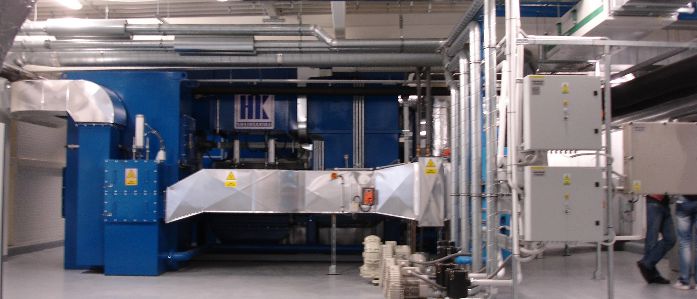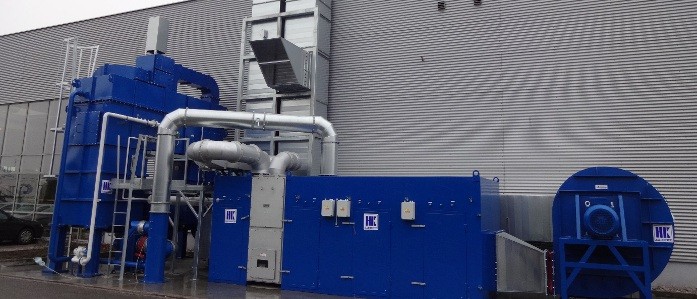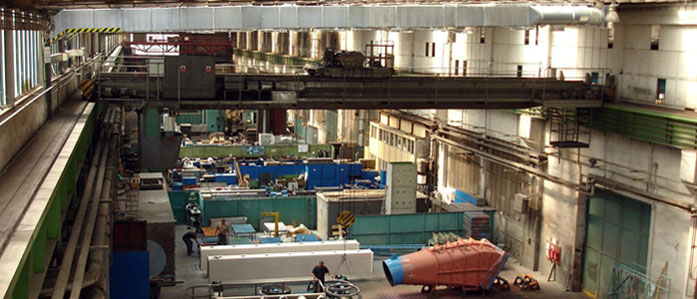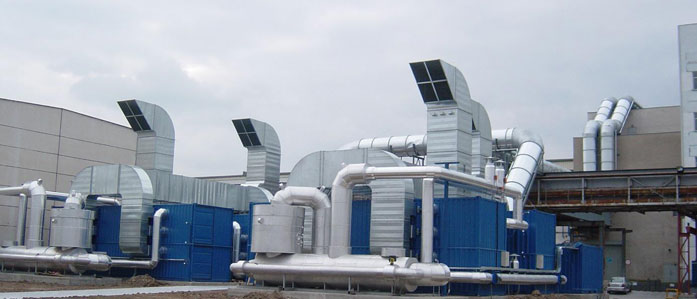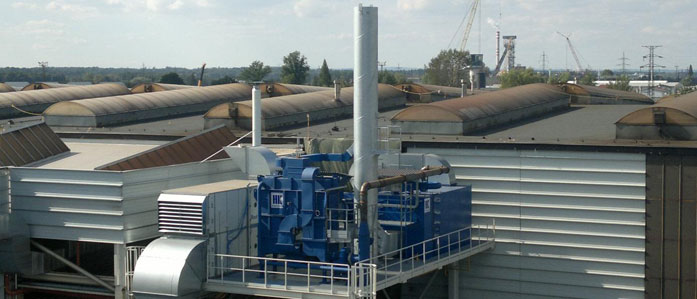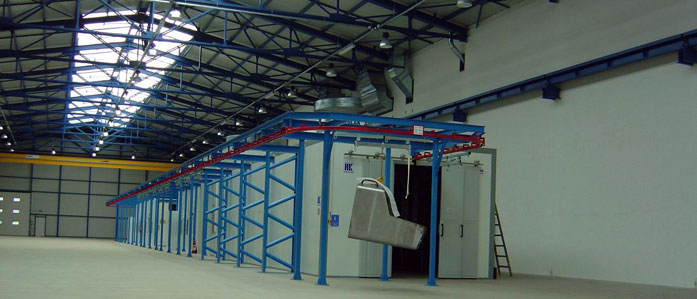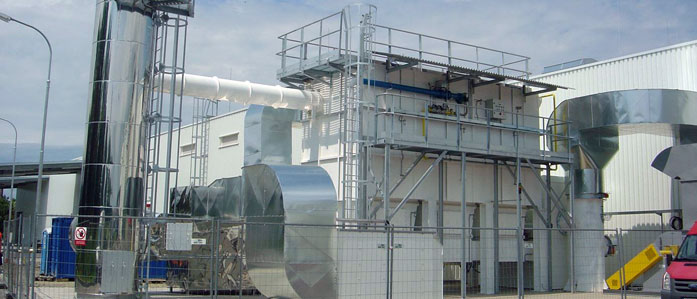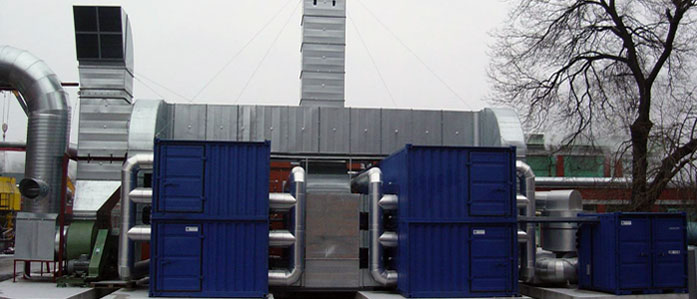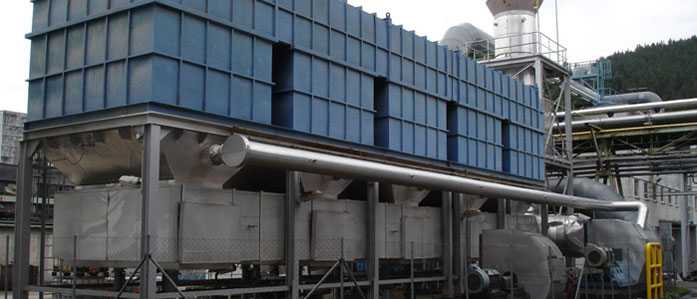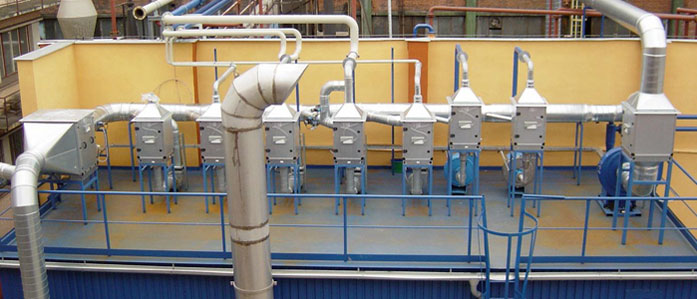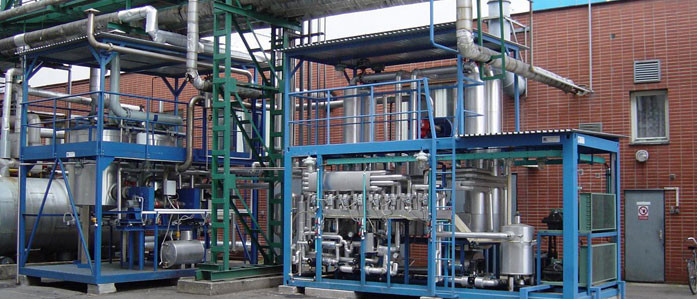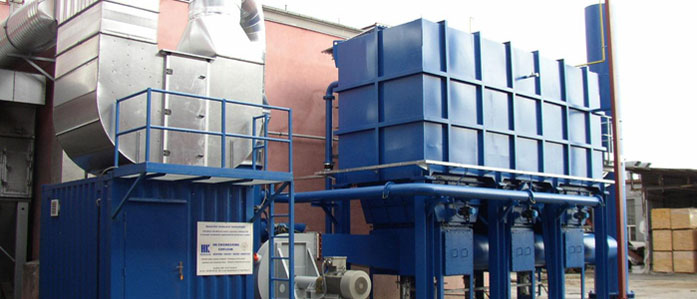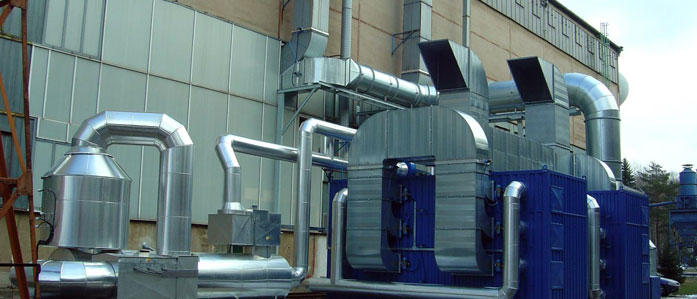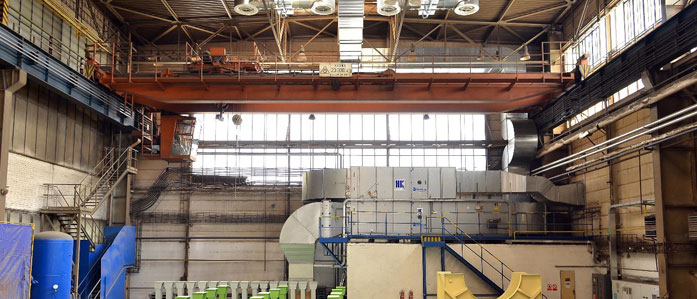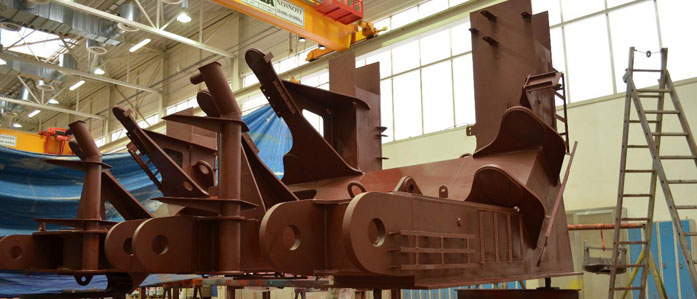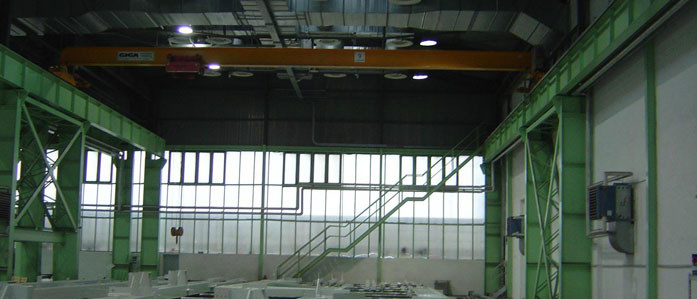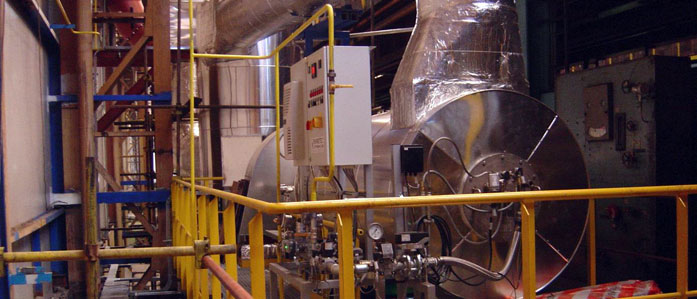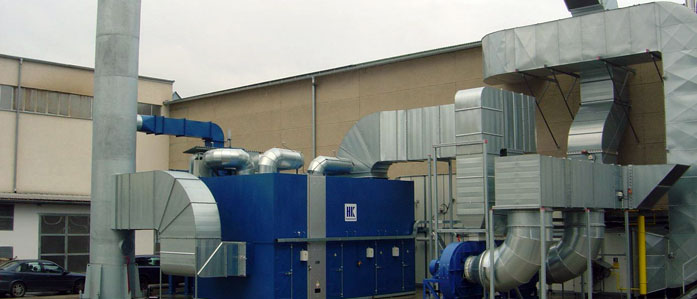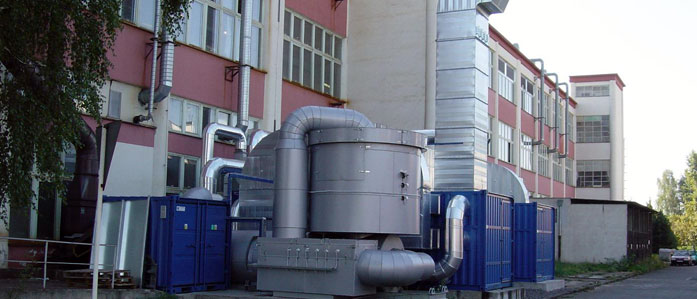OPEN-SPACE PAINT SHOPS INSTALLED IN PRODUCTION HALLS, INCLUDING TECHNOLOGIES FOR REMOVING VOC EMISSIONS
- Paint shops for large-sized components, rail and wheeled vehicles, containers and steel structures
- Technology for open-space painting with the use of sectional ventilation with ceiling-mounted nozzles
- Systems for removing VOC emissions from paint shops
- Combined spraying/drying booths with a sectional ventilation system
- Reconstruction, improvement and ecologisation of paint shops
HK ENGINEERING supplies coating systems, particularly painting technologies using sectional ventilation with long-range ceiling-mounted nozzles. This technology accounts for significant savings in investment and running costs as the volume of inlet air is significantly reduced and large-sized parts (such as steel structures) are painted in open spaces inside production halls, therefore, no large spraying booths need to be constructed.
Painting large-size parts, such as rail and wheel vehicles, steel structures, or containers, in standard enclosed booths requires large volumes of ventilation air to be supplied to and extracted from the booths. This leads to enormously high energy consumption and, if solvent-based paints are used, installation of expensive technologies for VOC removal from the waste air. Another negative aspect is limited handling of large-sized and heavy parts in enclosed spraying booths.
An ideal solution for large-sized steel structures, frames, containers and similar objects is the use of a system supplying air directly to the working area inside a production hall via long-range ceiling-mounted nozzles. Such nozzles allow heated air to be directed from a height of up to 20 m to the floor of the painting area or production hall.
The system of sectional ventilation with ceiling-mounted nozzles provides a directed supply of air. Since the nozzles are adjustable with servomotors, ventilation air may be supplied to the working area from various directions.
Ventilation air is removed through floor gutters in the relevant active section with the use of air-conditioning floor valves.
Description and function of ceiling-mounted nozzles:
The long-range ceiling-mounted nozzle supplied by HK ENGINEERING is a specially adjusted, highly inductive outfall with a swirling chamber, made of special, finned sheet metal, integrated into a connecting chamber, with a vertically adjusted regulation nozzle (long-range nozzle).
Air entering the connecting chamber flows tangentially along guiding elements to the swirling chamber, where an intense swirling stream is formed. Air flows out through the adjustable regulation nozzle (long-range nozzle) which controls the swirling power and distribution of the air stream according to the settings and position of the nozzles.
Air flowing tangentially along the guiding elements to the connecting chamber creates an intense swirling stream in the swirling chamber. Depending on the vertical position of the nozzle the following factors, determining the air stream shape, change:
- The volume of air fed above the nozzle and the swirling intensity of the supplied air. Since air fed above the nozzle does not flow along the nozzle contour but through the nozzle inside in the form of a vertical stream (guiding effect of the nozzle), the swirling intensity of the supplied air is reduced when the nozzle is in a low position. In a high position, the air flows along the nozzle’s outer contour and comes out, swirling, through the nozzle aperture between its outer contour and the front mask.
- The size of the nozzle aperture, which is formed between the regulation nozzle contour and the radially protruding front mask, influences the deviation and intensity of the swirling outlet stream.
By changing the nozzle position, overall swirling of the outlet air may be changed so that both horizontal and vertical streams are formed with variable induction and depth of the air stream range.
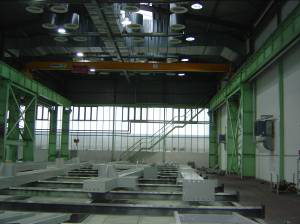 |
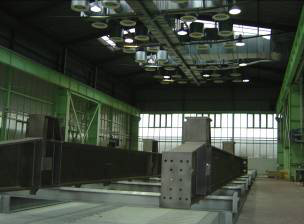 |
Above: Double-nave production hall for open-space painting of steel parts with sectional ventilation and ceiling nozzles located above the overhead crane. Below: Technology for removing emissions with VOC pre-treatment on a zeolite rotary concentrator and with a regenerative thermal oxidiser (RTO). Left: Zeolite rotary concentrator with a pair of main draught fans. Right: RTO with auxiliary desorption heating.
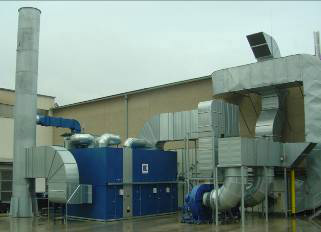 |
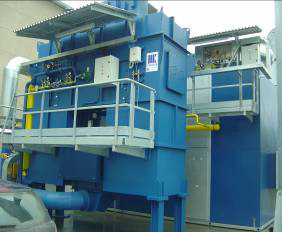 |
Further, a 3D design model of a supply realisation is shown.
A realised project with the following basic parameters: two painting areas (36x13m) divided into 24 sections; any two sections in a given space can always be in operation; technology of VOC emission removal for inlet waste air in a volume of 75,000 Nm3/hr.
A 3D model of a painting area with sectional ventilation using long-range ceiling-mounted nozzles and technology for removing VOC emissions
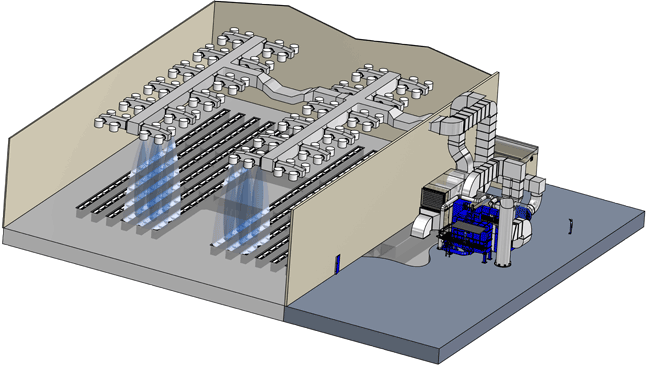
Principle of ventilation with long-range ceiling-mounted nozzles
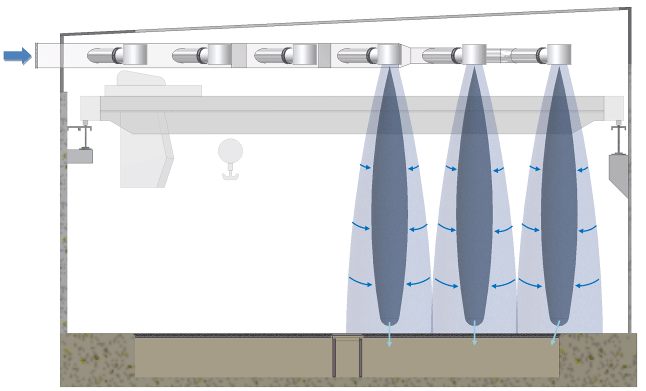
As shown above, due to the special structure of the ceiling-mounted nozzle and the formation of the swirling air stream, the main stream of fresh inlet air supplied to the working area of the relevant section draws so-called induced air from the surrounding space (see also Description of the ceiling-mounted nozzle function). Thus, neither the directed inlet air nor excessive paint disperses into adjoining non-active sections provided there is a floor suction gutter, and the inlet air – with respect to the energy provided by the ceiling-mounted nozzle – is carried, together with “peeled” excess paint, to the relevant suction area.
Basic properties of the section ventilation system with ceiling-mounted nozzles:
- Directed air supplied to the working area of an active painting section
- Fresh heated air supplied from a height of up to 20 m to the floor level
- Highly efficient removal of pollutants from the working area of an active section
- Sectional operation in the whole working area (ventilation runs only in the area where painting or degreasing is performed)
- Inlet air heated 3 °C above the temperature inside the hall
- Significant savings in energy thanks to the sectional operation
- Low running costs
- Spraying in currently ventilated zones (sections)
HK ENGINEERING also carries out reconstructions and ecologisation of paint shops, spraying booths and boxes. Reconstruction includes upgrading the coating process and air-conditioning system, filtering solid pollutants (aerosols from excess paint) and especially removal of VOC contained in the extracted waste air.
VOC removal technology for large paint shops or open-space painting areas
For paint shops and other coating facilities using organic solvent-based painting systems, HK ENGINEERING supplies proven systems for removing VOC in the waste air. These technologies are used especially for large volumes of extracted waste air and relatively low VOC concentrations.
- Zeolite rotary concentrator + regenerative thermal oxidiser (RTO) with auxiliary desorption heating – a continuous process of adsorption, desorption, oxidation (VOC incineration) – currently the world’s most commonly used and most economical concept. This system has numerous advantages compared to the other technology described below because it is practically insensitive to the composition of volatile organic substances and zeolite is non-flammable (unlike activated carbon) and hydrophobic (does not adsorb air humidity). This widely used technology is highly reliable, universal and safe.
- Static concentrators with activated carbon + catalytic recuperative oxidiser or recuperative thermal oxidiser (TO) or regenerative oxidiser (RTO) – a discontinuous, discreet process of adsorption, desorption, oxidation (VOC incineration). After adsorbing VOC, concentrators are switched over and desorbed with hot air from the oxidation unit. This technology may be applied only after thorough consideration of the composition of the coating materials used. Otherwise negative properties of activated carbon upon repeated adsorption and low-temperature desorption will take effect and a catalyst, if used, will show its sensitivity to catalyst poisons. Both these aspects, if not respected, can make the system non-functional very quickly. Currently, this technology is virtually out of use.
Application of the above-mentioned technological systems of VOC emission removal is best used for stationary air polluting sources producing VOC containing waste gases with a flow of tens to hundreds of thousands of m3/hr, with the VOC content in tens to hundreds of mg/m3.
In this case, specifically for large paint shops, any form of direct thermal removal of VOC is hardly acceptable regarding investment and running costs. /p>
In certain cases (low volume of waste air and high concentrations), the following technologies for removing VOC emissions may also be used separately:
- Regenerative thermal oxidiser (RTO)
- Catalytic oxidiser for low-temperature catalytic oxidation of VOC
- Recuperative thermal oxidiser (TO)
The following technologies (huge savings in purchase costs but very high running costs) may also be used for the given purpose:
- VOC adsorption and filtration systems
If required by the investor, complete supplies are realised as turnkey projects.




